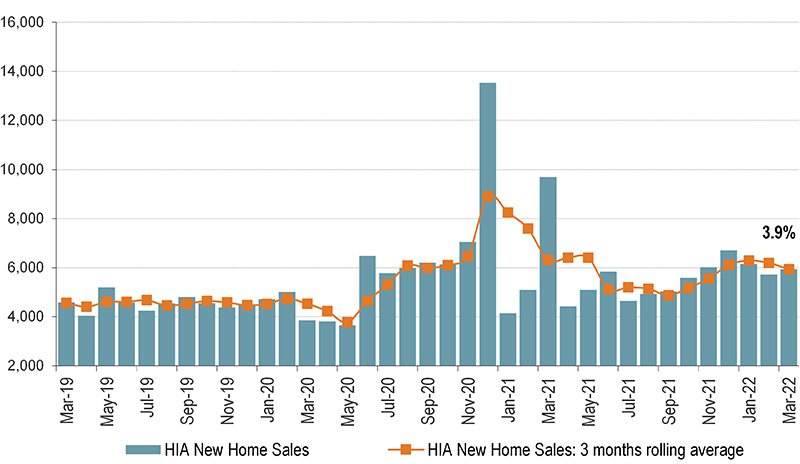Despite turbulence, more new homes being built and sold
Despite the turmoil associated with the building industry and rising interest rates and uncertain market conditions, the number of new homes being built and sold has increased.
Despite the turmoil associated with the building industry and prospective property buyers confronting rising interest rates and uncertain market conditions, the number of new homes being built and sold has increased.
New home sales increased by 3.9 per cent in March 2022 compared to the previous month, while the 2021 calendar year saw 147,760 detached house commencements, up by 30.5 per cent on the previous year and 11.6 per cent higher than the previous peak in 1988/89.
It was the strongest calendar year on record for detached house commencements, fell by 10.1 per cent in the final quarter of 2021.
Sales for the first three months of the year were lower by 2.8 per cent compared to the previous quarter but rose in March.
Released Wednesday (13 April), the HIA New Home Sales report – a monthly survey of the largest volume home builders in the five largest states – is a leading indicator of future detached home construction.
“Despite a difficult start to the year, with staff absences associated with the Omicron outbreak and extended holiday leave, new home sales continue to sustain levels usually associated with government stimulus and, excluding the period associated with the HomeBuilder stimulus, this is the second strongest quarter since 2016,” HIA Economist Tom Devitt said.
“Demand for new homes continues to be driven by a shortage of homes and an acutely tight rental market that has resulted in rapid house price and rental price growth.
“Tighter lending conditions have had minimal impact on the market to date.
“With rental vacancies at close to zero demand for new homes will continue and an increase in the cash rate is likely to be the turning point for a slowing in demand.” Mr Devitt said.
Private new house sales - Australia (seasonally adjusted)

Source: HIA
On a quarterly basis, sales in New South Wales increased in the three months to March 2022 to be 78.5 per cent higher than the equivalent quarter in 2019, before the pandemic. This was followed by Queensland (+33.3 per cent), Victoria (+19.1 per cent) and Western Australia (+15.4 per cent). South Australia saw the only decline over the period, down by 4.6 per cent.
Sector confidence, market uncertainty
The Reserve Bank of Australia (RBA) held interest rates steady again this month.
While the market is factoring in several rises in 2022, the RBA are yet to confirm when rates will begin to rise. In their most recent statement, the RBA simply indicated they want to see where inflation will settle before they act.
But the banks are not sitting around waiting for the RBA.
Westpac and ANZ, have both hiked fixed rates again today, as the cost of fixed rate funding continues to surge north. ANZ has hiked its one- to five-year fixed rates by up to 0.60 percentage points, while Westpac’s Thursday hike was its second in a week.
Herron Todd White CEO Gary Brinkworth said Property market activity to the end of March remained robust but there were clear signs the market was approaching a peak.
“(The interest rate situation) is adding further uncertainty to households whose budgets are becoming stretched,” he said.
“Some centres have done well, such as Brisbane which experienced a more than 6.0 per cent increase in home values for the year to date.
“Others saw growth attenuate, like Sydney and Melbourne who’ve both remained relatively flat in 2022.
“Looking ahead and the next quarter will, again, prove seminal on both the domestic and world stages.
“The war in Ukraine, supply chain pressures on construction, and fallout from recent east coast floods continue to put pressure on real estate markets.
“It’s obvious we’ll see turbulent forces influence our peaking property market over the coming weeks and months.”
Despite the uncertainties, confidence in Australia’s property sector has remained at historically elevated levels despite a less positive outlook on the economy, according to ANZ/Property Council’s latest industry survey.
The Confidence Index dropped 5 points nationally in the March quarter but remained in positive territory (137), buoyed by optimism about the economic outlook. A score of 100 in the Confidence Index is considered neutral.
Despite the small decline in confidence, Property Council of Australia Chief Executive, Ken Morrison, said stronger levels of confidence throughout the industry are positive for the overall economy.
“Given the extent of turbulence the sector has suffered over the previous quarter this is a resilient outcome that stays above the historic average.”
Mr Morrison said the industry’s forward work expectations have continued to lift this quarter, as have staffing level expectations.
“This means the property sector – which employs more Australians than any other sector – is set to hire more people and deliver more work, something both sides of politics should welcome as we begin the federal election campaign.
Future work expectations lifted in every State and Territory except the ACT over the quarter, with the biggest jumps recorded in SA (40 to 48 index points) and WA (45 to 53 index points).



















